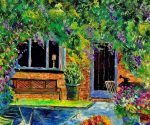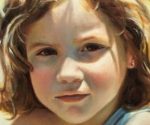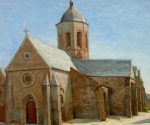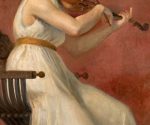20 Traditional Types of Indian Painting: Discovering the Artistic Legacy
India is a land of extraordinary stories, expressed in countless ways through different types of Indian art. The country’s painting traditions celebrate nature, faith, daily life, and more. Across regions, generations of Indian artist families have kept these creative legacies alive. Here, we explore the depth, history, and technique of 20 traditional Indian painting styles—perfect for discovering which art drawing inspires you most.
Must see: Folk Art and Paintings of India
1. Madhubani Painting
Started in the Mithila region of Bihar, Madhubani painting is famous for bold colors, geometric patterns, and mythological themes. Traditionally, women would decorate walls using plant-based pigments. There are actually five substyles—Bharni, Katchni, Tantrik, Godna, and Kohbar—each with a unique focus. Today, Madhubani painting easy techniques help beginners discover Indian art painting, making this vibrant folk art accessible worldwide. Look for imagery from nature, marriage celebrations, and divine stories in every stroke.
2. Kalamkari Art
Kalamkari, literally meaning “pen craft,” originated in Andhra Pradesh. The art is created using special tamarind pens and only natural dyes. Common motifs are peacocks, flowers, and scenes from epics like Ramayana. Kalamkari is considered among the most eco-friendly types of Indian art paintings. The blend of Persian and Indian designs gives it an elegant, storytelling appeal, making it a sought-after style for collectors and contemporary textile designers.
3. Warli Art Drawing
Warli art is one of Maharashtra’s most iconic forms. The Warli tribe paints their simple, symbolic designs on mud walls using rice paste. These compositions reflect tribal life—festivals, farming, hunting, and sacred rituals. Minimal geometric shapes, monochrome color schemes, and focus on everyday life make Warli art drawing a favorite for easy painting workshops and modern decor. It’s a brilliant bridge between ancestral art and today’s creative classrooms.
4. Pattachitra Painting
From Odisha and Bengal, Pattachitra is renowned for its delicate scrolls and temple stories. Artists use seashells, leaves, and natural stones for color. Scenes from Lord Jagannath’s life are especially popular, and sometimes the paintings appear on coconut shells, boxes, and fabrics. The combination of meticulous detailing and vibrant natural hues makes Pattachitra a jewel among types of India painting styles.
5. Phad Painting
In Rajasthan, Phad painting is the art of epic storytellers. Huge panels are painted with myths about local deities and heroes. These scrolls travel with priest-performers (‘Bhopa’), who animate the stories for villages. The use of vegetable dyes and bright reds, yellows, and oranges create a dramatic backdrop. Phad painting is less about single images and more about unfolding narratives—a true example of storytelling Indian art painting.
6. Thangka Painting
Though Thangka originated in Tibet, its spiritual influence is big in Himachal Pradesh and Ladakh. These scrolls, painted on cotton or silk, depict deities, mandalas, and scenes from Buddhism. Thangka painting is deeply symbolic, often used for prayer and meditation. Natural pigments and gold leaf add vivid detail, making Thangkas prized among collectors of Indian art forms.
7. Mughal Miniature Painting
Under the Mughals, Indian painting saw a major transformation. Mughal miniatures are small yet bursting with detailed scenes: royal courts, battles, hunts. The blend of Persian, Central Asian, and Indian styles brought lavish color and intricate brushwork. These types of Indian paintings, found in ancient manuscripts, now inspire contemporary artists experimenting with digital painting and fine art prints. Look for classic works like Hamzanama and Tutinama in museums.
8. Pichwai Painting
Pichwai art, from Rajasthan’s Nathdwara, charms viewers with rich depictions of Lord Krishna, especially as Shrinathji. These large cloth paintings hang in temples and homes, showcasing elaborate motifs and actors in Krishna’s dramatic, devotional life. Embellished details, bold colors, and storytelling scenes make Pichwai a treasured style within types of Indian painting styles.
9. Rajput Painting
From Rajasthan and Gujarat royal courts, Rajput painting expresses emotional depth through vivid colors and detailed ornamentation. It borrows techniques from Mughal art, but highlights stories of love, heroism, and devotion. The Kishangarh school is particularly famous for the elegant Bani Thani painting, a portrayal considered among the most famous paintings in the world. The renowned nihal chand painter remains the genius behind this masterpiece. Rajput painting reflects centuries of collaboration between tradition and personal style.
10. Gond Painting
Gond artists from Madhya Pradesh illuminate daily life, animals, and folklore in their paintings. The rhythmic patterns of dots, dashes, and purified lines recall the sounds of nature and tribal rituals. Vivid colors come from locally sourced materials such as plant juice, colored dirt, charcoal, and even cow dung. For those trying easy painting, Gond is a playful, heartfelt introduction to Indian art forms.
11. Kangra Painting
The Kangra school, part of Himachal Pradesh’s heritage, is celebrated for its delicate lines and romantic themes—often depicting Krishna and Radha in lush gardens. Soft pastels dominate, and there is an emphasis on realism and emotion. This branch of miniature painting is admired by collectors for its dreamy landscapes and gentle humanity.
12. Tanjore/Thanjavur Painting
Tamil Nadu’s Thanjavur painting is recognized by gold leaf decoration, colorful palettes, and glass beadwork. These paintings, usually of gods and goddesses, feature relief work that gives the art a three-dimensional effect. As one of the most visually captivating types of Indian art paintings, Thanjavur pieces radiate wealth and divinity wherever displayed.
13. Mysore Painting
Mysore paintings from Karnataka contrast with their Thanjavur counterparts; subtle coloring and fine brushwork create deeply devotional images. Usually done on silk or paper, Mysore style aims to evoke humility, peace, and connection with the divine. Gold leaf is used, but the effect is gentle, not lavish.
14. Paubha Painting
Originating in Nepal, Paubha was quickly adopted in Himalayan India for Buddhist spiritual expression. Painted on cotton or silk, these vibrant scrolls showcase intricate iconography—Buddhist deities, mandalas, and religious symbols. Like Thangka art, Paubha requires great skill and spiritual knowledge.
15. Kalighat Painting
Created around Kolkata’s Kali Temple, 19th-century Kalighat paintings feature bold outlines and earthy colors. Made on mill paper, Kalighat art covered scenes from myth, social satire, and even everyday life. The free-flowing lines inspired modern Indian artists such as Jamini Roy. In contemporary circles, Kalighat is a badge of Bengal artistic pride.
16. Bastar Tribal Art
Bastar, in Chhattisgarh, bursts with tribal energy in painting, craft, and sculpture. Artists use natural dyes, wood, and iron to present animals, folk legends, and rituals. The fusion of painting and craft in Bastar’s traditions showcases the diversity of Indian art forms within the tribal context.
17. Sohrai Art
Painted by the tribes of Jharkhand, Sohrai celebrates harvests and festivals with wall art of animal figures and geometric motifs. Pigments from local clay and plants keep the connection to nature strong. Sohrai is passed down through families, preserving themes of fertility and gratitude—perfect for those drawn to earthy types of Indian paintings.
18. Naga Tribal Art
Coming from Nagaland and Meghalaya, Naga tribal art incorporates painting on objects, textiles, and woodwork. The abstract motifs and bold colors express ancestral stories, rituals, and daily life. Naga art drawing techniques often inspire contemporary designers and craft revivalists.
19. Manipuri Painting
Manipur’s painting styles blend Buddhist and Hindu influences in temple murals and manuscripts. Bright colors and spiritual icons make Manipuri art a true fusion of faith and regional storytelling. Although rare, manuscripts illustrate the stories of gods, saints, and warriors.
20. Kerala Mural Painting
Kerala is famous for its breathtaking temple murals. Painted with natural pigments on walls, these large compositions feature gods, goddesses, and legendary heroes in detailed, dramatic poses. Kerala murals are seen as a benchmark for technical mastery and artistic expression in Indian art painting.
The Artists Behind the Legacy
No journey through Indian art forms is complete without recognizing Indian artist visionaries. Raja Ravi Varma modernized tradition, blending myth with realism. MF Hussain (or MF Husain) shook the world with bold colors and global themes, becoming one of the most famous artists to ever express Indian identity. Nihal Chand is immortal for Bani Thani’s enigmatic grace. New artists now find inspiration in warli art drawing, madhubani painting easy tutorials, and digital painting innovations, expanding the future of types of india painting.
Tradition, Trends, and Techniques
Indian painting styles remain timeless because artists blend ancient techniques with innovation. From easy painting for beginners in madhubani art and warli drawings, to advanced digital painting experiments, the scope of indian art painting grows every day. These works decorate temples, homes, galleries, and have even found space among the most famous painting in the world, across continents.
No matter your level, exploring Indian art forms is like stepping into a kaleidoscope of history, spirituality, and joy. Enjoy the journey!































